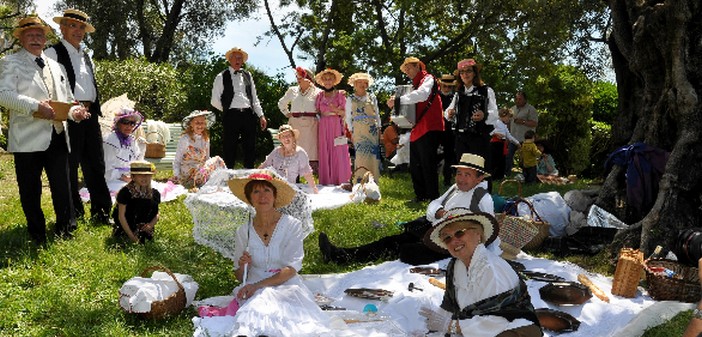In the context of heritage days, the Renoir Museum in Cagnes-sur-Mer was organizing a ‘1900’ picnic on the grass, complete with period costumes and cars. The style ranged from the Belle Époque to the Roaring Twenties. In a certain way, on this last day of summer, we were guests of Auguste Renoir.
After visiting his house and absorbing the essence of the artist, we found ourselves in this olive garden to have lunch. A picnic with white or checkered cloths, wicker baskets with the necks of wine bottles sticking out, cold meats, bread, cheeses, and fruits like plums and grapes.
Beautiful young women in costumes, their hats with intricate structures, and men in boaters, the garden of Renoir’s house was a patchwork of colors and imagination. One thinks of Renoir, imagines him being there among us. Surely the artist is in one of his studios sketching the outline of a young girl in bloom.
This picnic on the grass is an opportunity to forget our era when we no longer know how to stop and watch a butterfly in flight. Indeed, there is one drawing arabesques, its flight, like its life, is ephemeral and we linger to watch it come and go. Children run around, it’s life, and this picnic is an expression of it.
This original idea, besides teaching us or reteaching us to appreciate time and savor it, meant knowing how to enjoy a meal, knowing how to forget our cellphones, and simply knowing how to live.
Renoir’s house has become a museum where the artist is always present. Present through the layout of the place, present through the exhibited objects, often intimate, photos of his children, of himself, of his work, of his models.
Auguste Renoir is still there, you can feel it. It’s quite paradoxical, for he only lived here during the last ten years of his life, from 1908 to 1919. Films, photos, and a family album with children playing in the garden: Jean, Pierre, and Claude, carefree young boys, and their mother Aline. It’s Jean Renoir, who became a famous filmmaker, who would explain to us the genesis of this house.
Originally, there was only a farmhouse, which still exists today, and this olive garden, some of which were said to have been planted by the soldiers of Francis I, was threatened by a carnation field project.
Auguste Renoir bought the olive grove, saving the olive trees and having this house built, equipped with all the modern comforts of the time. He would live there for ten years, a decade of intense creation and a new experience, that of sculpture.
If Molière died on stage, Auguste Renoir died with a paintbrush in hand. This picnic afforded us the immense pleasure of rediscovering this artist, his house, and the places where he captured so many young women of Cagnes in the spring and bloom of their age.
Thierry Jan


